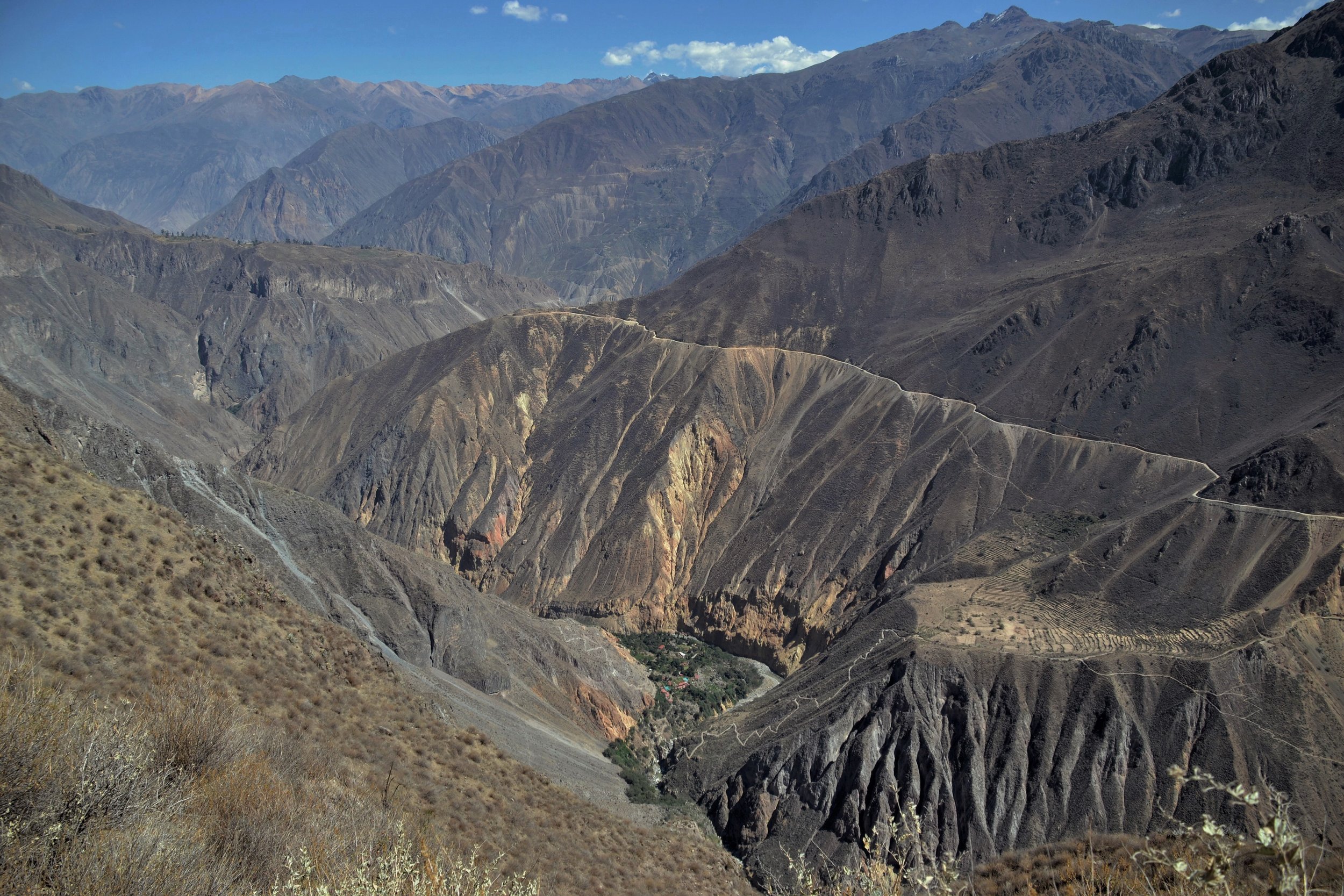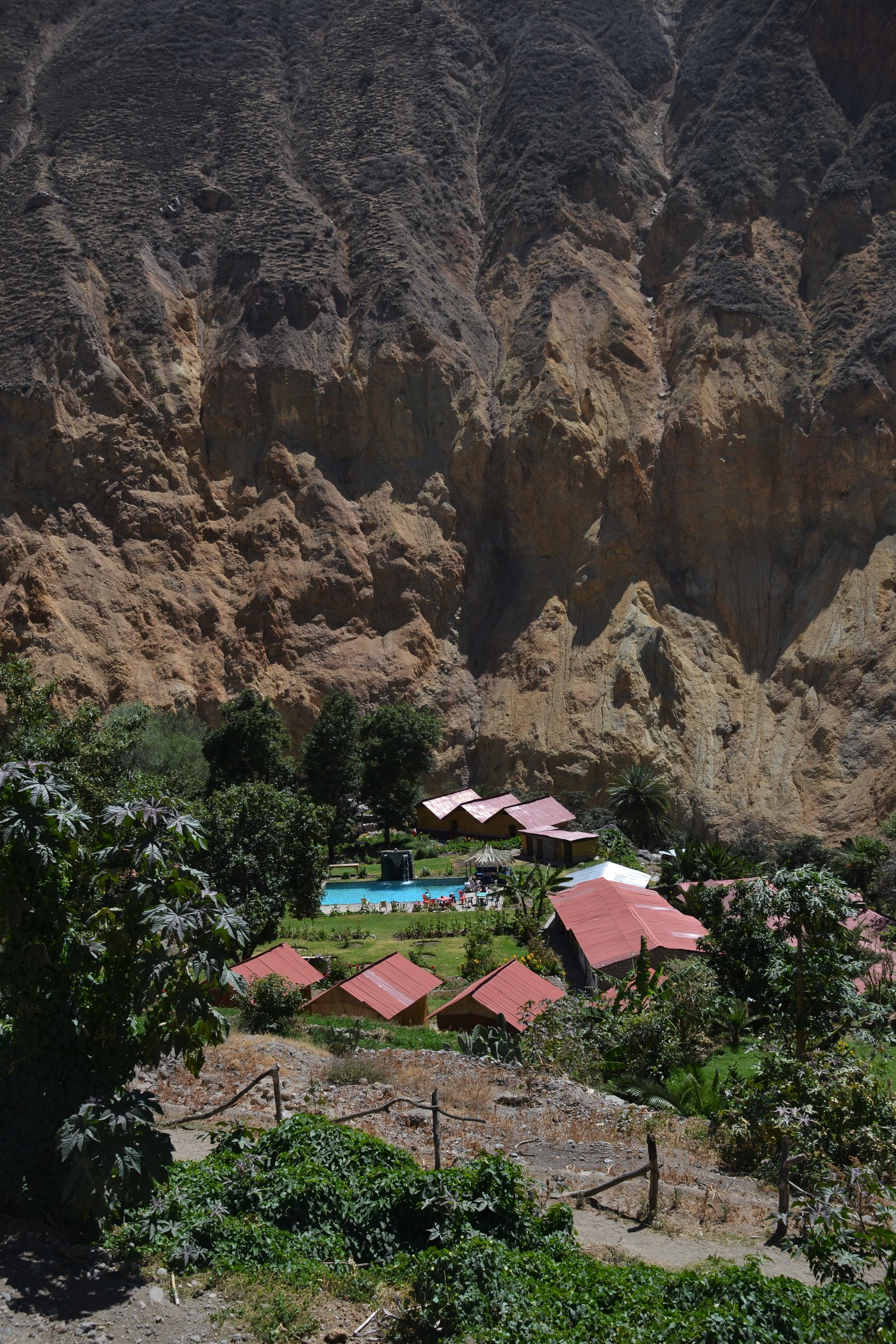The slopes of the Colca Canyon.
"That doesn't look so hard," I said.
I stood on a ledge studded with cacti, leaning on a wooden stick as the sun beat down. 28 degrees made for sweaty weather as my trekking group worked its way along the perilous ledges of the Colca Canyon--the second deepest canyon in the world, and one of Peru's most popular non-Machu Picchu trekking destinations.
My guide and I had paused along the path, to look at the next morning's destination. We could just about see it etched into a distant cliff-side: an erratic winding road from an oasis at the bottom of the rocky canyon to a crop of spindly trees at the top. It looked a long way up.
"Looks possible," I said, turning to my guide.
My guide smiled.
***
Trekking along the Colca Canyon.
I chose a three day trek through the Colca Canyon (two day versions are available, but you have to be faster on your feet than I).
The first day began with me bundling into a bus at 3.00am from the nearby Peruvian city of Arequipa, and travelling to the canyon. There, I met with my small trekking group (two fit French outdoorsmen, a chatty Dutch couple and a cheerful Belgian), and we spent the morning condor spotting. Condors, sometimes known as “Eternity Birds,” like to roost in the canyon, and tourists flock to designated viewpoints to watch them soar on thermals.
After the birdwatching, it was time to descend; a knee-jangling hike down to the base of the canyon, starting from a high point 3,500 metres up. At the bottom, a small village was waiting to offer my group meals and a place to slump unconscious.
The Colca Canyon.
At the beginning of the second day, my group decamped from this pokey little village (which was suspiciously overpopulated with tourist accommodation) and made for Paradise. The Paradise Lodge, that is, a small camp-cum-resort built atop a green oases further along the canyon. The lodge was crowded with swimming pools and swaying palms and weary trekkers, and there my group readied ourselves for the difficult third day.
The third day was reserved for the road my guide and I had spotted from the ledge; a steep clamber up 1050 metres of zig-zagging path to get out of the canyon. It's a hike made more difficult by the fact you have to start at 5am, and be finished in less than 3 hours, or you risk missing your bus back to Arequipa (so the guides insist, at least, and it seemed like a bad idea to keep them waiting).
My guide and his hat.
There was a bar in Paradise (I always knew there would be) selling pisco and cold beers. There, my guide cornered me. Named Roger--pronounced "Royer,"--he was a curious man. Intense but rarely serious, he had a contagious love for nature and a malevolent disdain for complainers. He urged me to hire a mule for the third day, because I had been slow on the first two, and he didn’t want me left behind.
Left: The oasis and the surrounding canyon. The third day of the Colca Canyon trek is reserved for climbing the canyon walls on the left side of the photo. Right: Paradise.
"People die," Roger said, sipping a cold beer, his expression somewhere between grim and whimsically drunk. "They have the lifestyle with the smoking and the drinking and they come here to climb without training, without being ready... they go up and their hearts explode or they fall... I always say, this is your vacation, you can spend a little more money, you don't have to kill yourself."
***
Hiking up the Colca Canyon at sunrise.
I was told there would be breakfast at the top.
The final day began in the dark, as a column of trekkers (my party and others) puffed and wheezed up the canyon wall—leaning on sticks, swigging water, and occasionally stopping to exchange wry grimaces.
It was, though intensely tiring, nowhere near as bad I had heard from others. I think sometimes the guides like to exaggerate, to make sure people are braced for hardship. Then again, in recent years there have been cases of tourists meeting unfortunate ends in the Colca Canyon, so perhaps there is some merit to the scare stories after all.
Elsewhere in the Colca Canyon
Roger was right when he implied there was something faintly peculiar about adventure tourism. As a person, I am about as effective outdoors as a fan-assisted oven, and my idea of a wild night out generally involves some kind of chocolate and a book. Yet I can’t keep from getting carried away when I see a cliffside, or a strange new city, or a jungle path that’s calling
It’s odd to take a holiday that leaves you feeling in need of a holiday. But occasionally, when the canyon’s pretty, you just can’t help yourself.
And luckily, there was indeed breakfast at the top.
EXTRA BITS:
> The mules cost 60 soles. Of course I walked instead. I'm cheap.
> Andean condors are nicknamed "Eternity Birds," because of their long lifespans; able to live up to 80 years, they are considered symbols of eternal life. I don't know how long eternity is, but that sounds like a hell of a bird.
> The two and three day tours of Colca Canyon have exactly the same itinerary, but with the two day version you have to be much faster. You skip the first night in the village and go directly to the oasis... where the swimming pools are all absolutely freezing by the time you arrive.
> The Lord of the Rings soundtrack would be perfect for this trek... though my guide warned our group off of using earphones, in case we were deaf to a possible landslide or earthquake. So on the other hand, maybe not.
> I'm back in Peru!

